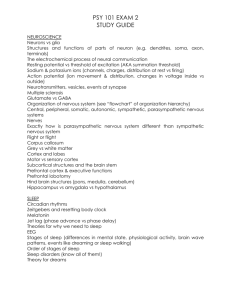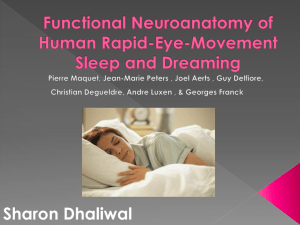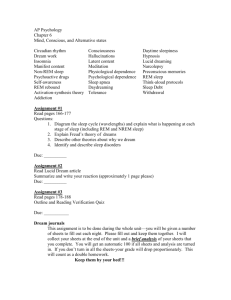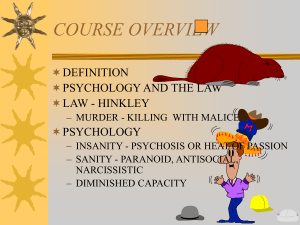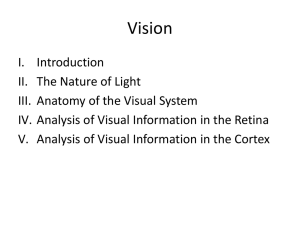doc
advertisement
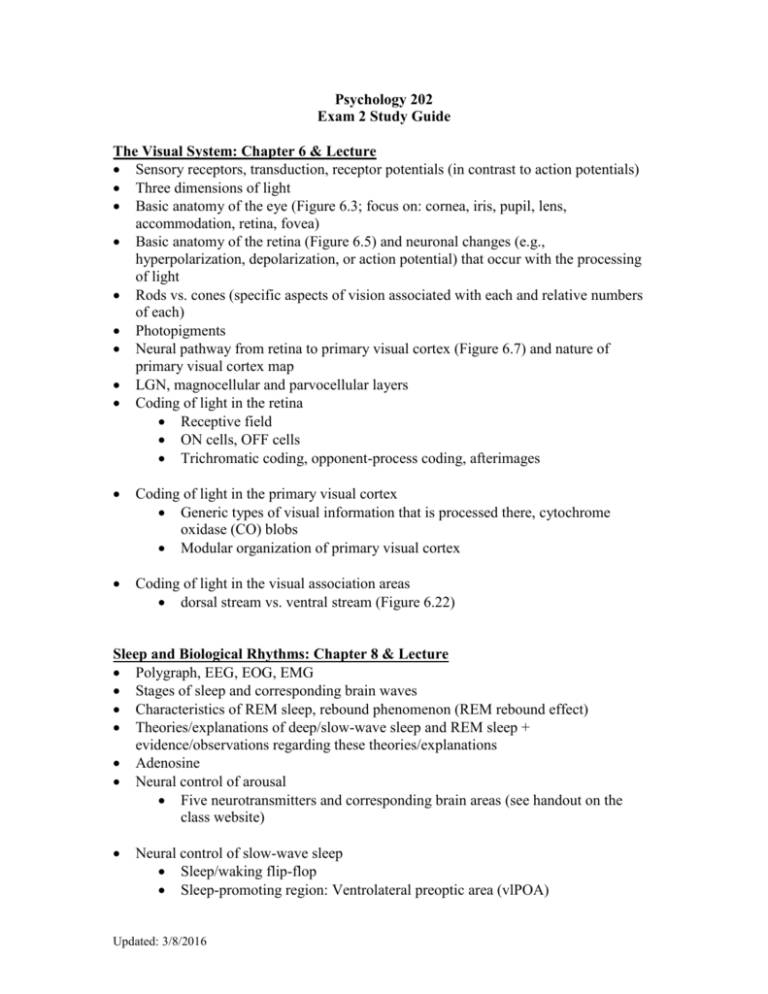
Psychology 202 Exam 2 Study Guide The Visual System: Chapter 6 & Lecture Sensory receptors, transduction, receptor potentials (in contrast to action potentials) Three dimensions of light Basic anatomy of the eye (Figure 6.3; focus on: cornea, iris, pupil, lens, accommodation, retina, fovea) Basic anatomy of the retina (Figure 6.5) and neuronal changes (e.g., hyperpolarization, depolarization, or action potential) that occur with the processing of light Rods vs. cones (specific aspects of vision associated with each and relative numbers of each) Photopigments Neural pathway from retina to primary visual cortex (Figure 6.7) and nature of primary visual cortex map LGN, magnocellular and parvocellular layers Coding of light in the retina Receptive field ON cells, OFF cells Trichromatic coding, opponent-process coding, afterimages Coding of light in the primary visual cortex Generic types of visual information that is processed there, cytochrome oxidase (CO) blobs Modular organization of primary visual cortex Coding of light in the visual association areas dorsal stream vs. ventral stream (Figure 6.22) Sleep and Biological Rhythms: Chapter 8 & Lecture Polygraph, EEG, EOG, EMG Stages of sleep and corresponding brain waves Characteristics of REM sleep, rebound phenomenon (REM rebound effect) Theories/explanations of deep/slow-wave sleep and REM sleep + evidence/observations regarding these theories/explanations Adenosine Neural control of arousal Five neurotransmitters and corresponding brain areas (see handout on the class website) Neural control of slow-wave sleep Sleep/waking flip-flop Sleep-promoting region: Ventrolateral preoptic area (vlPOA) Updated: 3/8/2016 Wakefulness-promoting regions: brain stem and basal forebrain systems (see “Neural control of arousal” above Role of orexin/hypocretin in stabilizing the flip-flop Neural control of REM sleep Desynchrony and atonia REM-sleep flip-flop REM-OFF region: ventrolateral periaqueductal gray matter (vlPAG; in the midbrain) REM-ON region: sublaterodorsal nucleus (SLD; in the pons) Biological Rhythms Circadian rhythms, zeitgebers Suprachiasmatic nucleus, PER protein (covered in lecture) Chapter 9: Reproductive Behavior Sexual dimorphism, sex chromosomes, gametes Gonads, testes, ovaries, function of SRY gene, testis-determining factor Organizational versus activational hormone effects Bipotential/bisexual nature of fertilized egg, Mullerian system, Wolfian System, androgens (testosterone and dihydrotestosterone), anti-Mullerian hormone, defeminizing and feminizing effects, demasculinizing and masculinizing effects (see handout & Figure 9.4) Genetic disorders (4 were discussed in lecture) and how the presence/absence of sex hormones produces the respective symptoms of each Primary versus secondary sex characteristics Structures and hormones involved in the changes that occur with puberty (see handout & Figure 9.5) Research evidence regarding the relation between prenatal hormones and sexual orientation 3 studies concerning genetic females 1 study concerning genetic males Three brain areas that distinguish among heterosexual males, homosexual males, and heterosexual females Concordance rates comparing twins Important brain areas involved in the sexual behavior of rats Medial preoptic area (MPA), medial amygdala, ventromedial hypothalamus (VMH) Areas responsible for sexual motivation versus sexual behavior Updated: 3/8/2016


